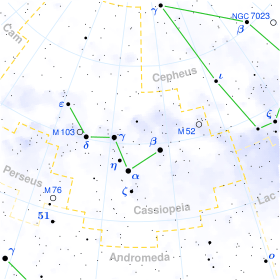Zeta Cassiopeiae
 ζ Cas is found just south of α Cas | |
| Observation data Epoch J2000 Equinox J2000 | |
|---|---|
| Constellation | Cassiopeia |
| Right ascension | 00h 36m 58.28419s[1] |
| Declination | +53° 53′ 48.8673″[1] |
| Apparent magnitude (V) | 3.66[2] (3.59 - 3.68[3]) |
| Characteristics | |
| Spectral type | B2IV[4] |
| U−B color index | –0.89[5] |
| B−V color index | –0.19[5] |
| Variable type | SPB[3] |
| Astrometry | |
| Radial velocity (Rv) | 2.0[3] km/s |
| Proper motion (μ) | RA: 17.38[1] mas/yr Dec.: –9.86[1] mas/yr |
| Parallax (π) | 5.50 ± 0.16[1] mas |
| Distance | 590 ± 20 ly (182 ± 5 pc) |
| Absolute magnitude (MV) | –2.8[6] |
| Details | |
| Mass | 8.3[3] M☉ |
| Radius | 5.9[3] R☉ |
| Luminosity | 5,500[3] L☉ |
| Surface gravity (log g) | 3.81[3] cgs |
| Temperature | 20,426[3] K |
| Metallicity [Fe/H] | –0.23[7] dex |
| Rotation | 5.37045[3] |
| Rotational velocity (v sin i) | 17 ± 3[3] km/s |
| Other designations | |
| Database references | |
| SIMBAD | data |
Zeta Cassiopeiae (ζ Cas, ζ Cassiopeiae) is a star in the constellation Cassiopeia. It has a blue-white hue and is classified as a B-type subgiant with an apparent magnitude of +3.66. It is approximately 590 light years from Earth.
ζ Cas is a probable member of an unusual group of variable stars known as "Slowly Pulsating B" (SPB) stars.[9] It shows a pulsation frequency of 0.64 per day (or once every 1.56 days) and displays a weak magnetic field with a strength of roughly 3.35 × 10−2 T, which varies with a period of 5.37 days.[10] This likely matches the rotation rate of the star, which, when combined with the low projected rotational velocity, indicates the star may be seen nearly pole-on. Zeta Cassiopeiae is a candidate magnetic Bp star that shows an overabundance of helium. The star contains a randomly oriented fossil magnetic field, which impacts the outflow of the stellar wind. Collisions between streams from this stellar wind creates a shock front, with cooling particles settling toward a co-rotating disk.[11]
Chinese name
In Chinese astronomy, Zeta Cassiopeiae is called 附路, Pinyin: Fùlù, meaning Auxiliary Road, because this star is marking itself and stand alone in Auxiliary Road asterism, Legs (mansion) (see : Chinese constellation).[12] 附路 (Fùlù) is westernized into Foo Loo, but the name Foo Loo was designated not only for Zeta Cassiopeiae, but also for η Cassiopeiae (Achird) by R.H. Allen, with the meaning is "a by-path" [13]
See also
- Lists of stars in the constellation Cassiopeiae
- Class B Stars
- Pulsating Variable Stars
References
- 1 2 3 4 5 van Leeuwen, F. (November 2007), "Validation of the new Hipparcos reduction", Astronomy and Astrophysics, 474 (2): 653–664, arXiv:0708.1752
 , Bibcode:2007A&A...474..653V, doi:10.1051/0004-6361:20078357
, Bibcode:2007A&A...474..653V, doi:10.1051/0004-6361:20078357 - ↑ Ducati, J. R. (2002). "VizieR Online Data Catalog: Catalogue of Stellar Photometry in Johnson's 11-color system". CDS/ADC Collection of Electronic Catalogues. 2237: 0. Bibcode:2002yCat.2237....0D.
- 1 2 3 4 5 6 7 8 9 10 Neiner, C.; Geers, V. C.; Henrichs, H. F.; Floquet, M.; Frémat, Y.; Hubert, A.-M.; Preuss, O.; Wiersema, K. (2003). "Discovery of a magnetic field in the Slowly Pulsating B star zeta Cassiopeiae". Astronomy and Astrophysics. 406 (3): 1019. Bibcode:2003A&A...406.1019N. doi:10.1051/0004-6361:20030742.
- ↑ Morgan, W. W.; Keenan, P. C. (1973), "Spectral Classification", Annual Review of Astronomy and Astrophysics, 11: 29, Bibcode:1973ARA&A..11...29M, doi:10.1146/annurev.aa.11.090173.000333
- 1 2 Johnson, H. L.; et al. (1966), "UBVRIJKL photometry of the bright stars", Communications of the Lunar and Planetary Laboratory, 4 (99): 99, Bibcode:1966CoLPL...4...99J
- ↑ Jaschek, C.; Gomez, A. E. (1998). "The absolute magnitude of the early type MK standards from HIPPARCOS parallaxes". Astronomy and Astrophysics. 330: 619. Bibcode:1998A&A...330..619J.
- ↑ Gies, Douglas R.; Lambert, David L. (March 1992), "Carbon, nitrogen, and oxygen abundances in early B-type stars", Astrophysical Journal, Part 1, 387: 673–700, Bibcode:1992ApJ...387..673G, doi:10.1086/171116
- ↑ "Zeta Cas -- Pulsating variable Star", SIMBAD, Centre de Données astronomiques de Strasbourg, retrieved 2010-02-22
- ↑ Neiner, C.; et al. (2003), "Discovery of a magnetic field in the Slowly Pulsating B star zeta Cassiopeiae", Astronomy and Astrophysics, 406 (3): 1019–1031, Bibcode:2003A&A...406.1019N, doi:10.1051/0004-6361:2003074 (inactive 2016-01-17)
- ↑ De Cat, P. (June 2007), "Observational Asteroseismology of slowly pulsating B stars", Communications in Astroseismology, 150: 167–174, Bibcode:2007CoAst.150..167D, doi:10.1553/cia150s167
- ↑ Smith, M. A.; Bohlender, D. A. (May 2007), "Variations of the ultraviolet resonance lines of the B2 IV-V star ζ Cassiopeiae", Astronomy and Astrophysics, 466 (2): 675–682, arXiv:astro-ph/0702461
 , Bibcode:2007A&A...466..675S, doi:10.1051/0004-6361:20066639
, Bibcode:2007A&A...466..675S, doi:10.1051/0004-6361:20066639 - ↑ (Chinese) AEEA (Activities of Exhibition and Education in Astronomy) 天文教育資訊網 2006 年 7 月 9 日
- ↑ Richard Hinckley Allen: Star Names — Their Lore and Meaning: Cassiopeia